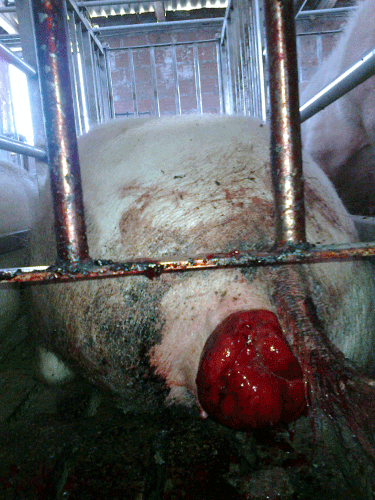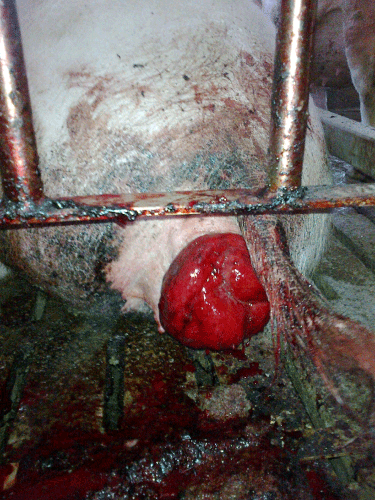|
|
| Vassilios Papatsiros1*, Labrini Athanasiou1, Athanasia Tzivara1, Giorgos Christodoulopoulos1, Giorgos Maragkakis1, Eleni Tzika2 and Panagiotis Tassis2 |
| 1Clinic of Medicine, Faculty of Veterinary Medicine, University of Thessaly, 43100, Karditsa, Greece |
| 2Farm Animal Clinic, Faculty of Veterinary Medicine, Aristotle University of Thessaloniki, 54627, Thessaloniki, Greece |
| *Corresponding authors: |
Vassilios G. Papatsiros
Clinic of Medicine
Faculty of Veterinary Medicine
University of Thessaly
Karditsa, Greece
E-mail: vpapatsiros@vet.uth.gr |
|
| Â |
| Received October 09, 2012; Published November 21, 2012 |
| Â |
| Citation: Papatsiros V, Athanasiou L, Tzivara A, Christodoulopoulos G, Maragkakis G, et al. (2012) Rectal Prolapse in Pregnant Sows due to Stall Housing. 1:516. doi:10.4172/scientificreports.516 |
| Â |
| Copyright: © 2012 Papatsiros V, et al. This is an open-access article distributed under the terms of the Creative Commons Attribution License, which permits unrestricted use, distribution, and reproduction in any medium, provided the original author and source are credited. |
| Â |
| Abstract |
| Â |
| The present case report regards an incidence of rectal prolapse in 7 pregnant sows of a farrow-to-finish pig farm of 200 sows. None of these sows suffered from respiratory or digestive diseases, showing severe coughing or diarrhoea. Moreover, laboratory examinations during the last semester did not reveal Leptospira spp. or mycotoxins at detectable levels. |
| Â |
| In the present case, we concluded that the main reason of rectal prolapse was that the sow stalls of this farm had the back retaining gate consisting of parallel bars, predisposing the incidence of rectal prolapse. Probably, the sows rested with the tail over the back gait, resulting in the pressure to be placed on the anus. This caused a partial relaxation of the sphincter, poor circulation and swelling. In the contrary, none of the sows of this farm, which were fixed in group housing, performed rectal prolapse. Finally, no surgical method or treatment was applied in sows with rectal prolapse, as farmer decided to send them in slaughterhouse. |
| Â |
| Keywords |
| Â |
| Sow; Rectal prolapse; Stall housing; Animal welfare; Swine |
| Â |
| Introduction |
| Â |
| Rectal prolapse can occur in all species of domestic animals, but it is most common in the swine [1]. In pigs, it occurs if support and fixation mechanisms (fascia, muscles, ligaments) are overcome by pressure (straining caused by constipation, diarrhoea, coughing) or the support tissues are weakened (fat or tumour infiltration, genetics, certain drugs or oedema due to mycotoxins, particularly zearalenone) [2,3]. In sows, a common cause of rectal prolapse is the abdominal strain during farrowing [2], flexibility and oedema of the connective tissue around the rectum and perineal area during lactation [4]. |
| Â |
| The present case study performs an incidence of rectal prolapse in 7 pregnant sows due to stall housing. |
| Â |
| Materials and Methods |
| Â |
| Animals |
| Â |
| The present case report regards an incidence of 7 pregnant sows of a farrow-to-finish pig farm of 200 sows (Large×White×Landrace) in Central Greece. The diameter and length of the prolapsed rectum of all sows varied from about 8 to 15 cm. The mucosa was haemorrhagic and oedematous (Figures 1 and 2). The sows were after 2nd to 5th parturition and the body condition scores were between 3 and 3.5. The rectal prolapses occurred 25-70 days after weaning and the sows were housed in individual stalls during the dry period. These sows exit the farrowing crate with a body condition score of about 2.5 at weaning. |
| Â |
|
|
Figure 1: Rectal prolapse of pregnant sow (45th day of pregnancy). |
|
| Â |
|
|
Figure 2: Rectal prolapse of pregnant sow (35 days after weaning). |
|
| Â |
| History of the farm |
| Â |
| The farm was seropositive to Porcine Reproductive and Respiratory Syndrome Virus (PRRSV) and Porcine Circovirus Type 2 (PCV2) infections. In addition, this farm has previous history with clinical signs and disorders of reproductive form of PRRSV in breeding stock, four years before. |
| Â |
| Herd health programme |
| Â |
| Routine serological Leptospira spp. testing in blood samples of pigs from all ages was performed annually in the farm. Also routine mycotoxicological analysis [zearalenone (ZEN), aflatoxines B1, B2, G1, G2, deoxynivalenol (DON), 3-acetyl-DON, 15-acetyl-DON, nivalenol] in feed raw materials was performed every semester by the laboratory of Provet S.A. (Aspropyrgos, Attiki, Greece). |
| Â |
| All sows of the farm were vaccinated against Aujeszky’s disease (AD), swine influenza (SI), parvovirus infection, atrophic rhinitis (AR), PRRSV, erysipelas, Escherichia coli and Clostridium perfringens infections (types A and C). All boars were vaccinated every 6 months against erysipelas, PRRSV, AD and SI. For the antiparasitic control, all breeding females were treated with a single ivermectin injection 14 days prior to each farrowing, and the boars twice a year. The feed provided to the animals were self-prepared based on a corn/barley/wheat-soya meal, depending on the season. |
| Â |
| Results and Discussion |
| Â |
| Laboratory examinations during the last semester did not reveal Leptospira spp. or mycotoxins at detectable levels (Table 1). In general, rectal vaginal prolapse is a common sequel to vulvovaginitis caused by mycotoxicosis [3]. |
| Â |
|
|
Table 1: Concentration of mycotoxins in feed raw materials which are able to cause health disorders in swine. |
|
| Â |
| None of these sows suffered from respiratory or digestive diseases, showing severe coughing or diarrhoea. Diarrhoea or coughing may precipitate rectal prolapse, but there are no objective data to support this hypothesis [2]. However, Gardner et al. [5] reported no relationship between coughing or diarrhoea and the prevalence of rectal prolapse. Moreover, no medication with antibiotics such as tylosin or lincomycin was applied in feed. The use of tylosin or lincomycin in medication feed may trigger rectal prolapse in pigs, due to edema [6]. |
| Â |
| In the present case, we concluded that the main reason of rectal prolapse was that the sow stalls of this farm had the back retaining gate consisting of parallel bars, predisposing the incidence of rectal prolapse. Probably, the sows rested with the tail over the back gait, resulting in the pressure to be placed on the anus. This caused a partial relaxation of the sphincter, poor circulation and swelling. In the contrary, none of the sows of this farm, which were fixed in group housing, performed rectal prolapse. Finally, no surgical method or treatment was applied in sows with rectal prolapse, as farmer decided to send them in slaughterhouse. |
| |
| Â |
| Housing system during gestation may influence the behavior of sows. In a study, including comparison of multiparous sows from group housing vs stall systems [7], reported that sows kept in gestation stalls made significantly more attempts to lie down, spent more time inactive and less time lying laterally than sows from groups. In addition, the relationship between stall size and the postural and motor activity in gestating sows is reported [8], as negative correlations were found between both stall length and sow length with the duration of time the sows were standing. The time taken to change from standing to lying posture was negatively correlated with stall length relative to animal length. Similar correlations were noticed between stall width relative to animal width and the duration of postural change from standing to sitting and from sitting to standing. Stall width relative to animal width is also reported negatively related to the frequency of postural change from standing to sitting. Consequently, the ability of pregnant sows in stalls to get up and lie down could be improved by increasing the space allowance within the stall [9]. |
| Â |
| Gestation sow housing methods are a contemporary animal welfare issue particularly in Europe and North America. Recently, a directive issued by the European Union (EU) requires in the 27 member states to stop using individual sow stalls during the gestation period, as from 1st January 2013 [10]. According to this directive, sows and gilts will be kept in groups during approximately 2 months and a half of their, resulting in more welfare friendly systems. The ban on individual sow stalls fulfils the modern consumer demands for more environmental friendly pig production in the EU. It is believed that this ban not only ensures that the food quality in the EU is of high quality benefiting consumer's health, but also achieves higher animal welfare standards. For example, benefits of the new farming system could be the increased survival rate of newborn piglets as well as the increasing productivity of sows and the improving maneuverability and comfort of sows [7,11,12]. |
| Â |
| Conclusion |
| Â |
| Housing system during gestation can influence the behavior of sows or gilts. The present case report conveys that the sow stalls can predispose the incidence of rectal prolapse in sows due to the back retaining gate consisting of parallel bars. It is possible that when the sows are rested with the tail over the back gait, the pressure is placed on the anus. This can cause a partial relaxation of the sphincter, poor circulation and swelling and resulting in rectal prolapse. |
| Â |
| |
| References |
| Â |
- Anderson DE, Miesner MD (2008) Rectal prolapse. Vet Clin North Am Food Anim Pract 24: 403-408.
- Straw BE, Zimmerman JJ, DÂ’Allaire S, Taylor DJ (2006) Diseases of Swine. (9thedn), Wiley-Blackwell Publishing.
- Osweiler GD (2006) Occurrence of mycotoxins in grains and feeds. (9thedn). Blackwell Publishing.
- Borobia-Belsué J (2006) Replacement of rectal prolapse in sows. Vet Rec 158: 380.
- Gardner IA, Hird DW, Franti CE, Glenn J (1988) Patterns and determinants of rectal prolapse in a herd of pigs. Vet Rec 123: 222-225.
- Zimmerman J, Karriker L, Ramirez A, Schwartz K, Stevenson G (2012) Diseases of Swine. (10thedn), Blackwell Publishing.
- Boyle LA, Leonard FC, Lynch PB, Brophy P (2002) Effect of gestation housing on behaviour and skin lesions of sows in farrowing crates. Appl Anim Behav Sci 76: 119-134.
- Anil L, Anil SS, Deen J (2002) Relationship between postural behaviour and gestation stall dimensions in relation to sow size. Appl Anim Behav Sci 77: 173-181.
- McGlone JJ, Von Borell EH, Deen J, Johnson AK, Levis DG, et al. (2004) Compilation of the Scientific Literature Comparing Housing Systems for Gestating Sows and Gilts Using Measures of Physiology, Behavior, Performance, and Health. Professional Animal Scientist 20: 105-117.
- Council Directive 2008/120/EC (2008) The protection of pigs. Summaries of EU legislation 47: 5-9.
- Bates RO, Edwards DB, Korthals RL (2003) Sow performance when housed either in groups with electronic sow feeders or stalls. Livestock Production Science 79: 29-35.
- Thodberg K, Jensen KH, Herskin MS (2002) Nursing behaviour, postpartum activity and reactivity in sows: effects of farrowing environment, previous experience and temperament. Appl Anim Behav Sci 77: 53-76.
|
| Â |
| Â |


